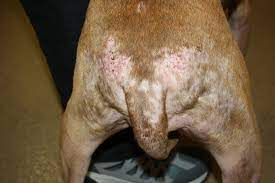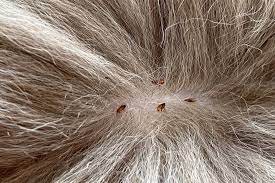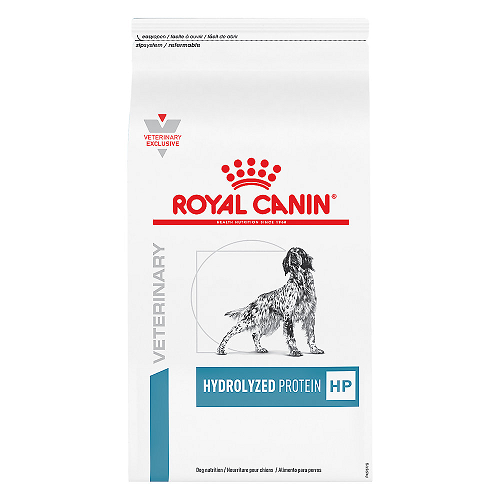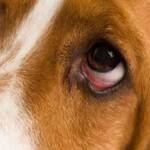Itchy Skin
Itching/scratching and excessive licking is very uncomfortable. Ongoing scratching and licking can lead to fur loss, skin infections that ooze and even balding patches.

There are a number of allergic conditions that can make your pet itch. Finding the cause is important to treating the condition.
Pets with food allergies have some of the most extreme symptoms of discomfort. Animals eat a variety of processed food proteins, flavorings, and colorings that are further processed inside their bodies.
Proteins may be combined or changed into substances recognized by the immune system as foreign invaders, which the immune system then attacks.
The result is inflammation which can present as year-round itching and sometimes diarrhea and vomiting.
As a general rule, cats itch around the face or neck which produces scabs and hair loss. In dogs, signs include facial itching, foot or limb chewing, itchy anal area, and recurrent ear infections.
Some people think that itching due to food allergy requires a recent diet change of some sort. In fact, the opposite is true.
Many animals become allergic to the diet that they are on. Allergies can develop over time. Many animals become allergic after eating the same food for several years.
That said, food allergies as a cause for itching and skin infections only represent about 12-15% of the cause in allergic patients. Other causes are environmental allergies or flea bite dermatitis.
What Kind of Allergy is It?
Diagnosing the underlying cause of allergic skin disease is essential so your pet can be treated appropriately. Cats and dogs can be allergic to insect bites, airborne substances such as molds, pollens, and dust mites as well as or food.
Some pets have more than one type of allergy that causes itching. When pets scratch or overgroom themselves they can create skin infections.
To solve the problem, the infection must be cleared, the itching managed and, if a cause is identified, removing the allergen from the environment.
In the case of grass/pollen allergies, which cannot be easily removed, finding a medical way to stop the itching is essential.

There is controversy about how common food allergy is in dogs and cats. Some veterinary dermatologists think it’s less common than other allergies and accounts for less then 15% of the allergic conditions seen.
There is no simple test for food allergy and even allergy testing for food-related causes are somewhat unreliable.
The below are things that help us decide it may be food related:
- The itching is not seasonal
- The itching is not limited to the paws or a single “hot spot.”
- Itching started when the pet was less than 6 months of age or greater than 5-6 years of age.
- No response to treatment for mange (a condition caused by mites that results in severe itching
- Corticosteroids and other allergy medications have not been helpful in managing the itching. Corticosteroids may or may not work on food allergy itching but they almost always work for other allergies.
- There are accompanying signs like vomiting or diarrhea. These are seen in 30 percent of food allergic pets.
Any of the above findings or observations warrant pursuit of food allergy.
Please note that several of the above criteria relate to what you observe at home. Trouble results when the veterinarian must speak to different family members about the pet and there is disagreement in their observations. It is best to have one person, preferably the one who has the most contact with the pet, be the spokesperson and make the relevant judgments.
The Flea Factor

Some animals have many allergies. It would not be particularly unusual for a pet to have a food allergy and another type of allergy at the same time.
Ensure immaculate flea control for any itchy pet! This makes it easier to rule out other causes for your pet’s itching
For more information on the current proliferation of flea products, see a product comparison chart so you can pick the best product for your situation. Remember, all dogs, cats and other mammals in the home must be treated.
The Hypoallergenic Diet Trial

Is Food allergy testing worth it?
The short answer is these tests can be very difficult to interpret. While in some cases it may be warranted, in the majority of cases the response to a food trial may be more helpful.
The Basic Principle
To determine whether or not a food allergy or intolerance is causing the skin problem, a hypoallergenic diet is fed for a set period of time. There are some commercially available diets from two of the largest veterinary food producers that hydrolyze the proteins in the food.
A hydrolyzed protein diet means that a conventional protein source is used but the protein is broken down into molecules too small to be recognized by the immune system. Discuss the options with your veterinarian.
If we see recovery with the test diet and itch with the original diet, then food allergy is diagnosed and the pet is returned to either the test diet or another appropriate commercial food indefinitely.
Before reviewing diet strategies for this process, here are some additional concerns:
- The diet must be strict (meaning the pet should not have any other protein sources besides the test protein). This includes rawhides and chew toys, flavored chewable medications (these will need to be changed for unflavored tablets) and vitamins, and treats.
- All family members must be on board with the trial. No one should be giving the pet other foods or treats when no one else is looking.
- It is probably best for all animals in the house to be fed the test protein so as not to have food-sharing issues.
- Itching must be managed during the trial in a way that the results of the trial are not foiled.
- Diet trials often span a season change period. If a dog has a pollen allergy and winter comes during the period of the diet trial, it may appear that the diet worked when, in fact, the seasons simply changed. This is why diet challenge is important at the end, even if the pet is doing well.
How Long to Feed the Trial Diet
Studies have shown that 80 percent of dogs will have shown a response by 4 to 6 weeks on the diet but by extending the diet to 8 weeks, 90 percent will respond.
The Labrador retriever and cocker spaniel appear to require longer trials. Most veterinary dermatologists recommend 8 to 12 weeks, which is a long time to be strict on the diet but that is the only way to detect food allergic dogs.
Most commercial diets used in food allergy trials have a 100 percent guarantee. This means that if your pet doesn’t like the food, the food can be returned for a complete refund, even if the bag is opened.
This is especially helpful for feline patients, as cats are famous for being choosy about what they are willing to eat.
What to do if the Diet is Successful?
To confirm food allergy, return to the original food; itching generally resumes within 14 days if food allergy was truly the reason for the itchy skin.
Many people do not want to take a chance of returning to itching if the patient is doing well; it is not unreasonable to simply stay with the test diet if the pet remains free of symptoms.
Often it is difficult to remember 10 to 12 weeks later how itchy the dog used to be before the diet trial. The diet challenge helps make it more obvious whether the diet trial has worked or not.
It is possible to more specifically determine the identity of the offending foods after the pet is well. To do this, a pure protein source (such as cooked chicken, tofu, wheat flour, or any other single food) is added to the test diet with each feeding.
If the pet begins to itch within 2 weeks, then that protein source represents one of the pet’s allergens. Return to the test diet until the itching stops and try another pure protein source.
If no itching results after two weeks of feeding a test protein, the pet is not allergic to this protein.
What to do if the Diet is Unsuccessful?
Assuming secondary skin infections have been controlled, an unsuccessful food trial is strongly suggestive that an inhalant allergy is the primary problem but there are some other considerations that should at least be mentioned:
- Are you certain that the dog received no other food or substances orally during the trial?
- Was sarcoptic mange ruled out?
- Your pet may require a longer diet trial. Are you certain regarding the factor which pointed toward the food allergy?
If your pet has not been biopsied, now may be a good time. If an inhalant allergy has risen to the top of the list, symptomatic relief either via medication, baths with specific shampoos, or allergy shots will likely be necessary. Chronic itchiness can be extremely uncomfortable and prompt relief is our goal as well as yours.


